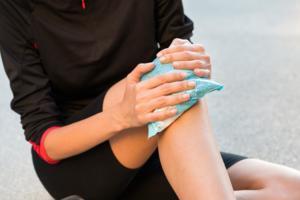![]() EXPERT
EXPERT
Dr. James A. Doran, D.C.
Chiropractor
- Denver, CO
- Palmer College of Chiropractic
- Accepting new patients
The Right Way to Treat a Whiplash Injury
Car accidents can cause various injuries; neck injuries are the most common. In many cases, these injuries can result in chronic pain and discomfort, making it difficult for...
Electroacupuncture: A Modern Solution for Pain Relief
Electroacupuncture combines the ancient principles of traditional acupuncture with modern electrical stimulation to provide an innovative approach to pain management. This advanced...
How Many Calories are Burned While Shoveling Snow?
Snow shoveling isn't fun, but it's usually unavoidable. If your driveway receives a lot of snow, it's crucial not to leave it unshoveled. It can melt and refreeze, creating an...
Should I Use Hot or Cold for an Injury?
Knowing when to use hot or cold therapy for an injury can be tricky -feeling sore after an aggressive workout? Twist your ankle or "tweak" your knee? What about a bump on the...
Exercises to Improve Your Posture
Maintaining good posture takes work. Long workdays (and weekends) spent sitting, hunching over phones, tablets, and laptops, and long commutes to the office take a toll. Fortunately,...
How to Prevent Whiplash Injuries
Research shows that most whiplash injuries in occur from rear-end collisions. While we can't predict or avoid when we may be in a motor vehicle collision, there are precautions...
Understanding Your Headaches and Finding Relief With Chiropractic Care
Regardless of how frequently (or infrequently) they occur, you don’t have to live with headaches. The International Headache Society found that headaches impact almost 40 percent...
10 Signs You Should See a Chiropractor
Seeing a chiropractor has many benefits that can dramatically improve your health. However, most people only think of seeing a chiropractor because they are in pain. While most...
How can I treat my hip joint pain?
Fortunately, effective and non-invasive treatments like chiropractic care, acupuncture, and dry needling can provide lasting relief. Understanding the source of your hip pain is crucial to determining the right course of action, especially when it comes to distinguishing hip joint issues from sacroiliac (SI) joint dysfunction.
What Is Hip Joint Pain?
The hip is a ball-and-socket joint formed by the head of the femur (thigh bone) and the acetabulum of the pelvis. This allows for a wide range of motion, making it one of the most flexible yet stable joints in the body.
Hip joint pain typically refers to pain that arises from within this joint structure. It may be caused by:
-Arthritis (osteoarthritis or rheumatoid)
-Labral tears
-Femoroacetabular impingement (FAI)
-Hip bursitis
-Tendinopathies
-Muscle imbalances
-Repetitive stress or postural problems
However, not all pain in the "hip area" originates in the actual hip joint. That's why accurate assessment is essential.
Differentiating Hip Joint Pain from Sacroiliac (SI) Joint Pain
It's common for people to say they have hip pain when the discomfort is actually coming from another region—especially the sacroiliac joint, which connects the base of the spine (sacrum) to the pelvis.
Characteristics of True Hip Joint (Acetabular) Pain:
-Felt deep in the groin or front of the hip
-Worsens with activities like walking, climbing stairs, or standing from a seated position
-May cause stiffness, reduced range of motion, or clicking
Characteristics of SI Joint Pain:
-Typically felt in the buttock, lower back, or just off to one side of the spine
-May radiate down into the thigh but not usually past the knee
-Feels worse when sitting for too long, transitioning between positions, or standing unevenly
A qualified provider, such as a chiropractor, can help you pinpoint the source of your pain through orthopedic testing and a thorough evaluation. Once the source is identified, treatment can be tailored to your specific needs.
Chiropractic Care for Hip Joint Pain
Chiropractic treatment is a safe and effective option for many people dealing with hip joint or SI joint pain. Chiropractors are trained to evaluate the entire musculoskeletal system, identify dysfunctions, and use hands-on techniques to restore alignment, reduce inflammation, and improve movement.
How Chiropractic Helps:
- Joint Adjustments: Gentle manipulation of the spine, SI joint, or even the hip joint itself can improve biomechanics and decrease irritation to surrounding tissues.
- Postural Correction: Many hip issues are caused or worsened by poor posture or pelvic imbalances. Chiropractors can address leg length discrepancies, pelvic tilt, and gait abnormalities.
- Soft Tissue Mobilization: Techniques such as myofascial release can reduce tightness in muscles like the piriformis, gluteus medius, or iliopsoas.
- Exercise Prescription: Chiropractors often provide therapeutic exercises that strengthen weak muscles and stretch tight ones, supporting long-term relief.
- Chiropractic care is especially successful when hip pain is mechanical, caused by joint misalignment, overuse, or muscular imbalances rather than a structural defect like a fracture or advanced arthritis.
Acupuncture for Hip Joint Pain
Acupuncture is a key component of Traditional Chinese Medicine that involves inserting very thin needles into specific points on the body to stimulate healing, relieve pain, and balance energy flow (qi).
In modern terms, acupuncture has been shown to:
-Trigger the release of endorphins and other natural pain-relievers
-Reduce inflammation
-Improve blood circulation to affected tissues
-Modulate the nervous system's pain response
-Conditions that Respond Well to Acupuncture:
-Osteoarthritis of the hip
-Tendinitis or bursitis
-Muscle strains and spasms
-SI joint dysfunction
-Referred pain from the lumbar spine
Patients often report reduced pain and greater ease of movement within a few sessions. When combined with chiropractic adjustments or dry needling, acupuncture can enhance the effectiveness of treatment and speed up recovery.
Dry Needling for Hip Joint Pain
While it may look similar to acupuncture, dry needling is a Western medical technique focused on trigger point therapy. A provider inserts sterile needles directly into tight or knotted muscle fibers, causing them to release, relax, and function normally.
This approach is especially helpful for:
-Piriformis syndrome
-Gluteal trigger points
-Iliopsoas tightness
-Quadratus lumborum (QL) dysfunction
-Referred pain patterns that mimic hip or SI joint pain
Dry needling can:
-Reduce muscle spasms and tension
-Restore normal movement patterns
-Increase flexibility
-Provide rapid pain relief when other methods fall short
It's often integrated into a comprehensive plan alongside chiropractic care and rehab exercises for optimal results.
What to Expect from Treatment
Your first step should be a comprehensive evaluation by a licensed practitioner. Whether you see a chiropractor, acupuncturist, or physical therapist, make sure they perform a detailed history, physical exam, and functional movement assessment.
A well-rounded treatment plan may include:
-Spinal and pelvic adjustments
-Manual therapy for soft tissue release
-Acupuncture or dry needling
-Stretching and strengthening exercises
-Ergonomic and lifestyle advice
Most people see meaningful improvements within a few weeks, especially when they follow through with recommended home care and consistent visits.
When to Seek Help
-You should seek professional care for hip joint pain if:
-Pain lasts more than a few days or keeps returning
-You feel stiffness, locking, or clicking in the joint
-Pain is interfering with your daily activities or sleep
-There is radiation into the thigh or groin
-You've experienced a fall or trauma
It's also worth seeking help before the pain becomes severe. Chronic joint pain often leads to compensation in other parts of the body—causing knee, back, or ankle problems that can be harder to fix down the road.
You Don't Have to Live With Hip Joint Pain
Hip joint pain can disrupt your life—but it doesn't have to define it. Whether your pain stems from the acetabular joint, SI joint, or surrounding muscles and tendons, there are proven, non-invasive treatments that can help you feel better and move more freely.
Chiropractic care, acupuncture, and dry needling offer safe, drug-free solutions that address the root causes of pain—not just the symptoms. They work well alone or as part of a comprehensive care plan, and are most effective when started early.
If you're struggling with hip joint pain, don't wait. Find a qualified chiropractor or provider who offers these treatments and start your path toward healing and recovery.
What are the potential causes of neck pain and stiffness, and how can you provide relief?
What exercises to avoid with lower back pain?
Exercises to Avoid With Lower Back Pain
If you’re experiencing lower back pain, steer clear of the following exercises to prevent further strain:
1. Sit-Ups and Crunches
Why Avoid? These exercises put significant pressure on the spine and can worsen disc-related issues or strain the lower back muscles.
Better Alternative: Try partial crunches or modified planks to strengthen your core without overloading the spine.
2. Heavy Lifting (Deadlifts and Squats)
Why Avoid? Lifting heavy weights, especially with improper form, can compress the spine and exacerbate lower back pain.
Better Alternative: Use bodyweight exercises like glute bridges or focus on lighter resistance exercises under professional guidance.
3. Forward Bends (Toe Touches)
Why Avoid? Repeated bending at the waist can overstretch the ligaments in the spine and strain the lower back muscles.
Better Alternative: Opt for gentle stretches like a seated forward fold with proper support.
4. High-Impact Activities (Running or Jumping)
Why Avoid? High-impact exercises like running or plyometrics can jar the spine and worsen inflammation.
Better Alternative: Choose low-impact activities like walking, swimming, or stationary cycling to stay active.
5. Twisting Movements
Why Avoid? Exercises that involve rapid or excessive twisting, such as Russian twists, can strain the lower back and exacerbate pain.
Better Alternative: Focus on static core exercises, like bird dogs or side planks, to build stability without twisting.
6. Back Extensions
Why Avoid? Overextending the spine, especially with weighted back extensions, can compress the lower back and worsen conditions like spondylolisthesis.
Better Alternative: Incorporate gentle stretches like the cat-cow pose to improve flexibility without added strain.
General Tips for Exercising With Lower Back Pain
Listen to Your Body: If an exercise causes pain, stop immediately. Pain is your body’s way of signaling that something isn’t right.
Warm Up Properly: Always start with light movements to prepare your muscles and joints for activity.
Focus on Posture: Maintaining proper alignment during exercises reduces unnecessary strain on the spine.
Progress Gradually: Avoid sudden increases in intensity or weight, as this can overload the lower back.
When to Seek Professional Guidance
If you’re unsure about which exercises are safe, consulting a healthcare professional, such as a chiropractor, can be invaluable. Chiropractors can assess your spinal alignment and guide you on safe movements to prevent injury. Additionally, therapies like dry needling can release tight muscles and improve mobility, complementing your exercise routine.
The Path to Recovery
Lower back pain doesn’t have to limit your ability to stay active. By avoiding harmful exercises and focusing on gentle, supportive movements, you can protect your spine and promote healing. Always consult a professional if your pain persists or worsens, and remember: consistency with the right exercises is key to long-term back health.
How can I improve my flexibility and range of motion to support spinal health?
The Importance of Flexibility and Spinal Health
Flexibility and range of motion play a key role in keeping your spine healthy and pain-free. Tight muscles and limited movement can place stress on your vertebrae, leading to discomfort and even injury over time. Regular stretching and strengthening exercises can reduce tension, enhance mobility, and support proper spinal alignment.
Simple Stretching Exercises for Spinal Health
Incorporate these stretches into your routine to improve flexibility and spinal health. Perform each exercise gently and avoid pushing through pain.
1. Cat-Cow Stretch
Start on your hands and knees in a tabletop position.
Inhale as you drop your belly towards the floor, lifting your head and tailbone (Cow Pose).
Exhale as you round your back towards the ceiling, tucking your chin and pelvis (Cat Pose).
Repeat 8–10 times to warm up the spine and improve mobility.
2. Seated Forward Fold
Sit on the floor with your legs extended straight in front of you.
Hinge forward at your hips and reach for your toes, keeping your back as straight as possible.
Hold the stretch for 20–30 seconds to gently release tension in the hamstrings and lower back.
3. Spinal Twist
Sit on the floor with your legs extended.
Cross your right leg over your left, placing your right foot flat on the floor.
Twist your torso to the right, placing your right hand behind you and your left elbow outside your right knee.
Hold for 20–30 seconds on each side to improve spinal rotation and flexibility.
4. Child’s Pose
Kneel on the floor and sit back on your heels.
Extend your arms forward as you lower your chest toward the ground.
Hold for 30 seconds to gently stretch the lower back and shoulders.
Strengthening Exercises for Spinal Support
Strengthening the muscles that support your spine is just as important as stretching. These exercises help maintain proper posture and reduce the risk of injury.
1. Bridge Pose
Lie on your back with your knees bent and feet flat on the floor, hip-width apart.
Press into your heels and lift your hips towards the ceiling.
Hold for 5 seconds, then lower back down.
Repeat 10–15 times to strengthen your glutes and lower back.
2. Bird Dog
Start in a tabletop position.
Extend your right arm and left leg simultaneously, keeping your back straight.
Hold for a few seconds, then return to the starting position.
Repeat 10–12 times on each side to improve balance and core stability.
Postural Habits to Prevent Back Pain
Beyond exercise, maintaining good posture throughout your day is crucial for spinal health. Here are a few tips:
Sit Smart: Choose a chair with good lumbar support, keep your feet flat on the floor, and avoid slouching.
Stand Tall: Distribute your weight evenly on both feet, and avoid locking your knees.
Move Regularly: Avoid staying in one position for too long. Set reminders to stand, stretch, and walk every 30–60 minutes.
How Chiropractic and Dry Needling Can Help
While stretching and strengthening exercises are excellent for spinal health, professional therapies like chiropractic care and dry needling can enhance your results. Chiropractors can identify areas of spinal misalignment and use gentle adjustments to improve mobility and reduce tension. Similarly, dry needling targets trigger points in tight muscles, promoting relaxation and faster recovery from stiffness or pain.
Consistency Is Key
To improve your flexibility and range of motion, consistency is essential. Dedicate just 10–15 minutes daily to stretching and strengthening exercises, and practice mindful posture throughout the day. If you’re dealing with chronic pain or stiffness, consider consulting a healthcare professional for personalized recommendations.
Take the first step towards better spinal health today—your body will thank you for it!
How long is the treatment for middle back pain?
First off, it's crucial to pinpoint the cause of your middle back pain. This involves a thorough examination and possibly X-rays. Once we understand what's causing the pain, we can develop a personalized treatment plan.
Treatment for middle back pain can involve a combination of therapies, including acupuncture, chiropractic, or dry needling. We often prescribe exercises to strengthen and stretch the muscles in your back, posture correction techniques, and possibly some lifestyle changes.
The duration of your treatment plan can vary from person to person. Some people might find relief relatively quickly, while others may need more time. The cause of your pain (acute vs. chronic) and your lifestyle (desk work vs. heavy lifting) will affect the length of your treatment.
Fortunately, because of the anatomy of the middle back compared to the neck (cervical) and lower back (lumbar), it typically improves faster than these other conditions. Most of the patients in our office find noticeable relief within two to four visits.
Ultimately, the goal of your treatment should be to alleviate your current pain but also to address the underlying issues to prevent it from coming back in the future. So while the exact timeline for treatment can vary, our focus is always on helping you get back to feeling your best as efficiently and effectively as possible.
Can knee arthritis pain go away?
Exercises to strengthen the muscles around the knee, losing weight if necessary, using assistive devices like braces or canes, and certain medications can all help to relieve pain and improve function. In some cases, more advanced treatments like injections or surgery may be recommended.
Some important and often overlooked treatments for knee arthritis are acupuncture, chiropractic, and shockwave therapy. Chiropractic adjustments to the knee and lower back can help slow the progression of arthritis by improving joint function. Acupuncture and shockwave therapy are also helpful for pain relief and reducing inflammation in the joints
What activities to avoid with a herniated disc?
Should I see a chiropractor if I threw my back out?
How long does it take a herniated disc to heal without surgery?
doctor of chiropractic for an exam and x-rays. The results of these tests will tell your doctor how best to approach your treatment and determine if you need any additional testing.
Can chiropractors help with ankle pain?
What sleeping position is best for your back?
Whats wrong with my back?
Can a chiropractor fix a rolled ankle?
Can a chiropractor help with dislocated rib?
What is the best way to correct posture?
How long does it take for a pinched nerve in the neck to heal?
Why does my back crack when I stretch?
How long after a chiropractic adjustment do you feel better?
Medications can work quickly but they are simply masking your problem. Imagine driving down the road and your car makes a funny noise so you turn up the radio. The problem is still there, you just can't hear it. Truly making positive changes in the body takes time. Just like losing weight, straightening your teeth, or getting in shape to run a 10 k.
Give your chiropractor time to work on your problem and follow their directions on icing, stretching, and ergonomics. Even if you don't get relief from the first adjustment, very soon you will notice less pain, increased ROM, and better mobility. Most chiropractic patients present with problems that began weeks or months earlier so they can take time to resolve.
Physical neck/head/shoulders
Whoever examined you after your fall was probably focused on the head injury, a potentially more severe problem. Alternating hot and cold on your neck can provide some relief, but to resolve your problem, have the injury evaluated by a chiropractor as they specialize in spinal injuries.
What helps nerve pain in the arm?
Chiropractic adjustments restore motion to segments in the spine that are fixed (subluxated). The adjustment removes pressure from the nerves that exit between the vertebrae and relieves nerve pain.












